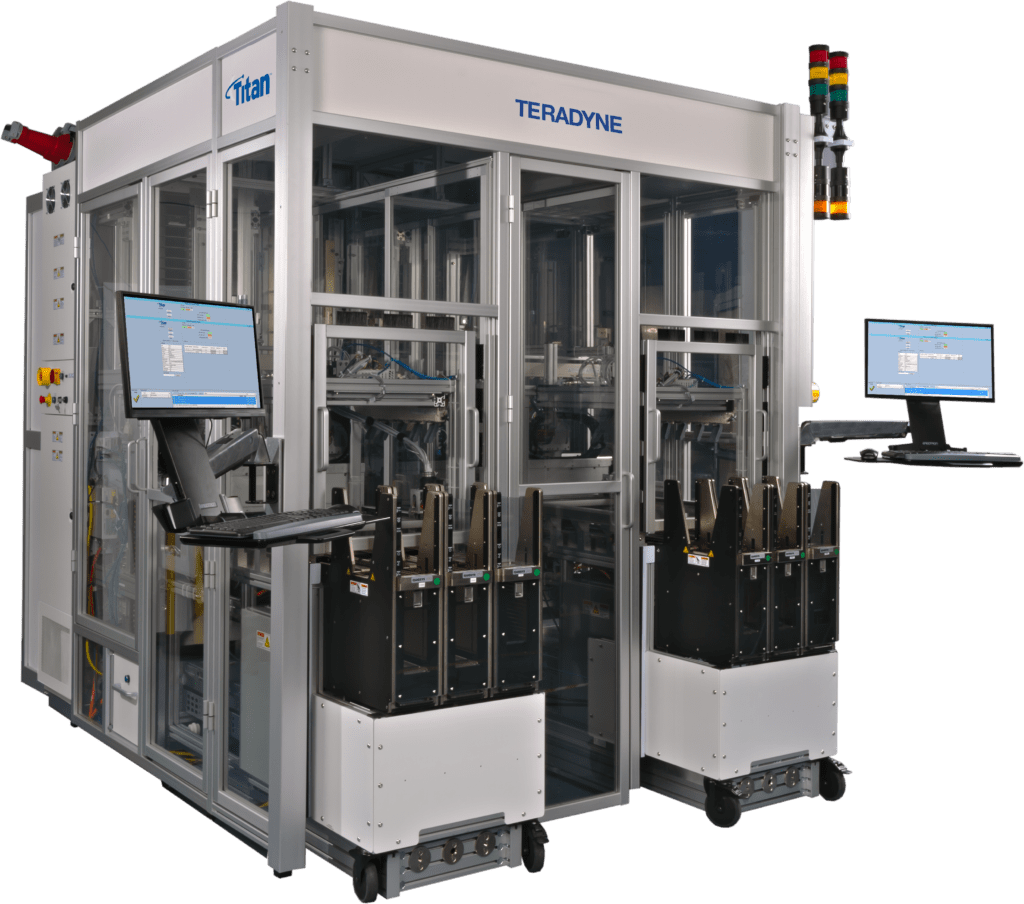System Level Test (SLT)
What Is System Level Test (SLT)?
System Level Test (SLT) enables IC manufacturers to emulate the final user environment in order to test software and validate connections between IP blocks. It is a more effective and less expensive way to test I/O protocol stacks, IP block to block interfaces and different clock, power, thermal and hardware/software domain interactions.
Why Teradyne?
As the leader in wafer and package ATE test equipment, Teradyne’s Titan platform has been testing smartphone applications for years. SLT has also been adopted in other applications such automotive ADAS and infotainment as well as AI data servers.
Semiconductor components continue to grow in complexity with technologies like 5G, Artificial Intelligence (AI), Augmented Reality (AR) and Virtual Reality (VR). With process nodes continuing to shrink, IC designers are creating complete System-on-Chip (SoC) products that contain processor cores, analog I/O, digital I/O, modems and other IP blocks along with embedded software.
This additional complexity is leading to more and more untested transistors and to longer test times. By utilizing SLT as a third test process, following wafer and package test, component manufacturers can test software and validate connections between IP blocks in a manner that isn’t otherwise practical.
SLT also provides additional coverage to meet stringent end customer failure rate requirements for improved product quality. It therefore complements the structural and functional testing performed at ATE wafer and package testing.
Teradyne’s Titan platform delivers low cost of test, fast time to market and the ability to ramp to ultra-high device volume. For years, it has been a proven solution for the mobile application processor market. Teradyne is at the forefront of change and growth in the System Level Test industry and will continue innovating to bring improved cost and quality benefits to the ADAS, Infotainment, AI and data server, GPU and tablet markets.

Download our System Level Test – A Primer white paper
What Is Driving SLT in the Semiconductor Test Flow?
As technologies evolve—test needs evolve. For example, AI devices today may contain billions of transistors. As process nodes continue to shrink, even a 99.5% ATE fault coverage leaves a large number of transistors untested. SLT testing finds the faults in the remaining 0.5% of untested transistors.
Complex technologies have increased SoC, System-In-Package (SIP) and software complexities. This complexity results in more asynchronous interfaces, more interactions among power, clock and thermal domains as well as software and hardware. These interactions create more effort to achieve the 99.5% ATE fault coverage. SLT provides an easier and less expensive way to test complex interfaces. And, by exercising devices in mission mode it tests the complex interactions where faults may exist.
Another challenge device manufacturers face is shorter time to market and higher defects on new device processes. This results in having to ship product while processes still have high defect rates and the need to identify the defects to ship quality product. SLT enables the engineer to achieve improved fault coverage early in the device development. This data is critical in reducing the time to good yield and reducing overall time to market by not having to wait for final process yield improvements.
Finally, IC designers are taking advantage of leading-edge process and package developments. While these developments are exciting and necessary, they also introduce more opportunity for latent faults and new failure modes. SLT lowers the overall cost of the device with the ability to catch potential faults before a device is shipped.
Teradyne’s SLT Solutions

Titan
Teradyne’s Titan platform delivers low cost of test, fast time to market and the ability to ramp to ultra-high device volume. For years, it has been a proven solution for the mobile application processor market. Teradyne is at the forefront of change and growth in the SLT industry and will continue innovating to bring improved cost and quality benefits to the ADAS, Infotainment, AI and data server, GPU and tablet markets.